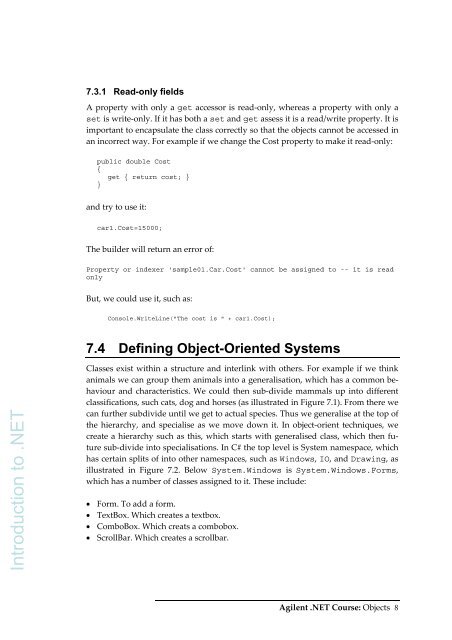Complete set: Intro to C - Bill Buchanan
Complete set: Intro to C - Bill Buchanan
Complete set: Intro to C - Bill Buchanan
You also want an ePaper? Increase the reach of your titles
YUMPU automatically turns print PDFs into web optimized ePapers that Google loves.
7.3.1 Read-only fields<br />
A property with only a get accessor is read‐only, whereas a property with only a<br />
<strong>set</strong> is write‐only. If it has both a <strong>set</strong> and get assess it is a read/write property. It is<br />
important <strong>to</strong> encapsulate the class correctly so that the objects cannot be accessed in<br />
an incorrect way. For example if we change the Cost property <strong>to</strong> make it read‐only:<br />
public double Cost<br />
{<br />
get { return cost; }<br />
}<br />
and try <strong>to</strong> use it:<br />
car1.Cost=15000;<br />
The builder will return an error of:<br />
Property or indexer 'sample01.Car.Cost' cannot be assigned <strong>to</strong> -- it is read<br />
only<br />
But, we could use it, such as:<br />
Console.WriteLine("The cost is " + car1.Cost);<br />
7.4 Defining Object-Oriented Systems<br />
duction <strong>to</strong> .NET<br />
<strong>Intro</strong><br />
Classes exist within a structure and interlink with others. For example if we think<br />
animals we can group them animals in<strong>to</strong> a generalisation, which has a common behaviour<br />
and characteristics. We could then sub‐divide mammals up in<strong>to</strong> different<br />
classifications, such cats, dog and horses (as illustrated in Figure 7.1). From there we<br />
can further subdivide until we get <strong>to</strong> actual species. Thus we generalise at the <strong>to</strong>p of<br />
the hierarchy, and specialise as we move down it. In object‐orient techniques, we<br />
create a hierarchy such as this, which starts with generalised class, which then future<br />
sub‐divide in<strong>to</strong> specialisations. In C# the <strong>to</strong>p level is System namespace, which<br />
has certain splits of in<strong>to</strong> other namespaces, such as Windows, IO, and Drawing, as<br />
illustrated in Figure 7.2. Below System.Windows is System.Windows.Forms,<br />
which has a number of classes assigned <strong>to</strong> it. These include:<br />
• Form. To add a form.<br />
• TextBox. Which creates a textbox.<br />
• ComboBox. Which creats a combobox.<br />
• ScrollBar. Which creates a scrollbar.<br />
Agilent .NET Course: Objects 8










![Unit 5. Switches and VLANs [PDF]](https://img.yumpu.com/34422504/1/184x260/unit-5-switches-and-vlans-pdf.jpg?quality=85)





